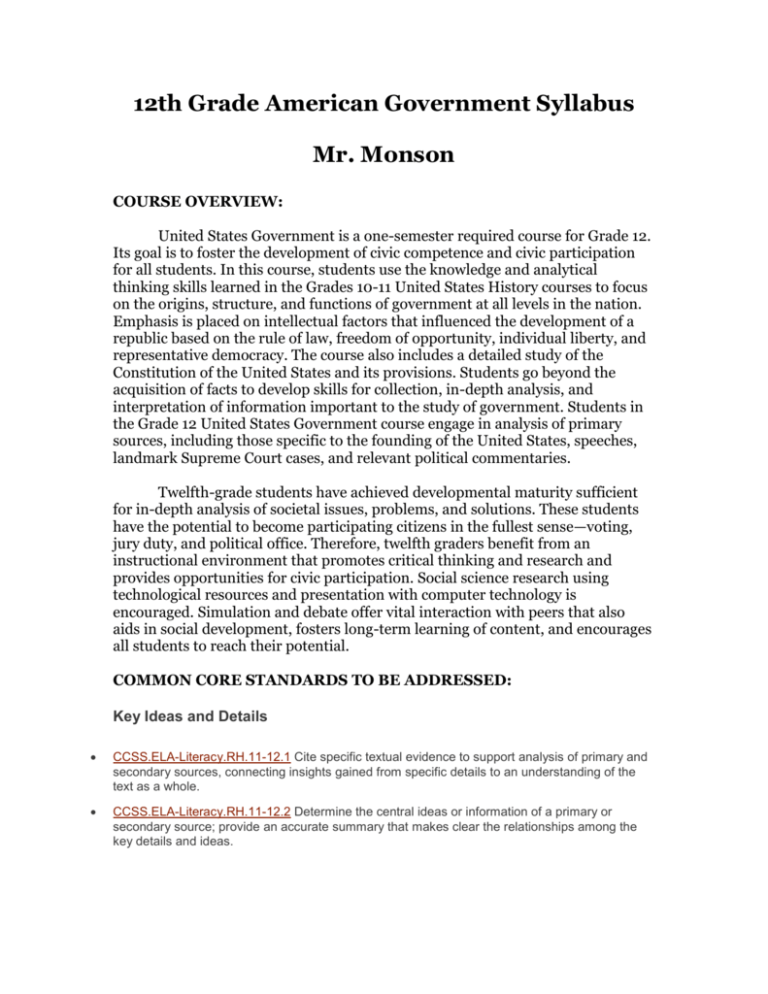12th Grade American Government Syllabus
advertisement

12th Grade American Government Syllabus Mr. Monson COURSE OVERVIEW: United States Government is a one-semester required course for Grade 12. Its goal is to foster the development of civic competence and civic participation for all students. In this course, students use the knowledge and analytical thinking skills learned in the Grades 10-11 United States History courses to focus on the origins, structure, and functions of government at all levels in the nation. Emphasis is placed on intellectual factors that influenced the development of a republic based on the rule of law, freedom of opportunity, individual liberty, and representative democracy. The course also includes a detailed study of the Constitution of the United States and its provisions. Students go beyond the acquisition of facts to develop skills for collection, in-depth analysis, and interpretation of information important to the study of government. Students in the Grade 12 United States Government course engage in analysis of primary sources, including those specific to the founding of the United States, speeches, landmark Supreme Court cases, and relevant political commentaries. Twelfth-grade students have achieved developmental maturity sufficient for in-depth analysis of societal issues, problems, and solutions. These students have the potential to become participating citizens in the fullest sense—voting, jury duty, and political office. Therefore, twelfth graders benefit from an instructional environment that promotes critical thinking and research and provides opportunities for civic participation. Social science research using technological resources and presentation with computer technology is encouraged. Simulation and debate offer vital interaction with peers that also aids in social development, fosters long-term learning of content, and encourages all students to reach their potential. COMMON CORE STANDARDS TO BE ADDRESSED: Key Ideas and Details CCSS.ELA-Literacy.RH.11-12.1 Cite specific textual evidence to support analysis of primary and secondary sources, connecting insights gained from specific details to an understanding of the text as a whole. CCSS.ELA-Literacy.RH.11-12.2 Determine the central ideas or information of a primary or secondary source; provide an accurate summary that makes clear the relationships among the key details and ideas. CCSS.ELA-Literacy.RH.11-12.3 Evaluate various explanations for actions or events and determine which explanation best accords with textual evidence, acknowledging where the text leaves matters uncertain. Craft and Structure CCSS.ELA-Literacy.RH.11-12.4 Determine the meaning of words and phrases as they are used in a text, including analyzing how an author uses and refines the meaning of a key term over the course of a text (e.g., how Madison defines faction in Federalist No. 10). CCSS.ELA-Literacy.RH.11-12.5 Analyze in detail how a complex primary source is structured, including how key sentences, paragraphs, and larger portions of the text contribute to the whole. CCSS.ELA-Literacy.RH.11-12.6 Evaluate authors’ differing points of view on the same historical event or issue by assessing the authors’ claims, reasoning, and evidence. Integration of Knowledge and Ideas CCSS.ELA-Literacy.RH.11-12.7 Integrate and evaluate multiple sources of information presented in diverse formats and media (e.g., visually, quantitatively, as well as in words) in order to address a question or solve a problem. CCSS.ELA-Literacy.RH.11-12.8 Evaluate an author’s premises, claims, and evidence by corroborating or challenging them with other information. CCSS.ELA-Literacy.RH.11-12.9 Integrate information from diverse sources, both primary and secondary, into a coherent understanding of an idea or event, noting discrepancies among sources. Range of Reading and Level of Text Complexity CCSS.ELA-Literacy.RH.11-12.10 By the end of grade 12, read and comprehend history/social studies texts in the grades 11–CCR text complexity band independently and proficiently. The preceding standards were taken from the following website: http://www.corestandards.org/ELA-Literacy/RH/11-12 Topics to be addressed: The following are the topics that will be covered in the semester of American Government. Week1-2: Origins of American Government Week 3-4: Principles of United States Government Week 5-6: Constitutional construction and Make-up Week 7-8: Legislative Branch Week 9-10: Executive Branch Week 11-12: Judicial Branch Week13-14: Political Parties Week 15-16: Voters and Voting Behavior Week 17-18: Comparative Government and Review for Exam *** This is plan is subject to change based on needs of the class. *** Grading Scale and Weights: The grading scale for this course is designed within the Social Science Department framework. This course uses a graduated weighting system, which places more work on the test portion of the course. This is done in order to help prepare student for the undergraduate college experience. Grades and weighting are as follows: TESTS: 60 % CLASSWORK/ DAILY WORK/ QUIZZES: 30 % CLASS PARTICIPATION/HOMEWORK: 10%











